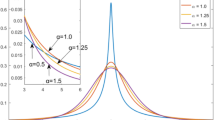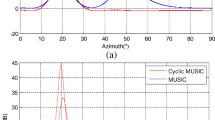Abstract
We consider the problem of direction-of-arrival (DOA) estimation for cyclostationary signals in impulsive noise modeled as a complex symmetric α-stable (SαS) process. Since the DOA estimation based on second-order cyclic statistics degrades seriously in an α-stable distribution noise environment, we define a novel pth-order cyclic correlation by fusing the fractional lower order statistics and second-order cyclic correlation. After briefly introducing the statistical characteristics of pth-order cyclic correlation and building the extended data model, we first propose a novel extended pth-order cyclic MUSIC algorithm (EX-POC-MUSIC) by exploiting both pth-order cyclic correlation and pth-order cyclic conjugate correlation. The algorithm allows us to select desired signals and to ignore interference in the communication system. Second, in order to increase the resolution capabilities and the noise robustness significantly, an improved EX-POC-MUSIC algorithm called the extended pth-order cyclic Root-MUSIC (EX-POC-RMUSIC) algorithm is also presented. This algorithm has all the merits of the EX-POC-MUSIC algorithm, and it is also a fast DOA estimation algorithm because it avoids spatial spectrum searching. Under some conditions, both proposed algorithms are able to handle more sources than the number of sensors. Simulation results strongly verify the effectiveness of the two algorithms.







Similar content being viewed by others
References
H. Belkacni, S. Marcos, Robust subspace-based algorithms for joint angle/Doppler estimation in non-Gaussian clutter. Signal Process. 87, 1547–1558 (2007)
R.F. Brcich, D.R. Iskander, A.M. Zoubir, The stability test for symmetric alpha-stable distributions. IEEE Trans. Signal Process. 53(3), 977–986 (2005)
P. Charge, Y. Wang, J. Saillard, An extended cyclic MUSIC algorithm. IEEE Trans. Signal Process. 51(7), 1695–1701 (2003)
W.A. Gardner, Simplification of MUSIC and ESPRIT by exploitation of cyclostationarity. IEEE Trans. Commun. 76, 845–847 (1988)
W.A. Gardner, A. Napolitano, L. Paura, Cyclostationarity: half a century of research. Signal Process. 86(4), 639–697 (2006)
A.B. Gershman, H. Messer, Robust mixed-order root-MUSIC. Circuits Syst. Signal Process. 19(5), 451–466 (2000)
A.B. Gershman, P. Stoica, Direction finding using data-supported optimization. Circuits Syst. Signal Process. 20(5), 541–549 (2001)
J.G. Gonzalez, J.L. Paredes, G.R. Arce, Zero-order statistics: a mathematical framework for the processing and characterization of very impulsive signals. IEEE Trans. Signal Process. 54, 3839–3851 (2006)
X. He, Z.M. Liu, J. Bin, Performance of direction of arrival estimation based on support vector regression in impulsive noise environment, in 2009 International Conference on Wireless Communications & Signal Processing, (2009), pp. 1–4
B. Kannan, W.J. Fitzgerald, Beamforming in additive alpha-stable noise using fractional lower-order statistics (FLOS), in Proceedings of IEEE International Conference on Electronics, Circuits and Systems, vol. 3 (1999), pp. 1755–1758
J.H. Lee, Y.J. Lee, A novel direction-finding method for cyclostationary signals. Signal Process. 81, 1317–1323 (2001)
T.H. Liu, J.M. Mendel, A subspace-based direction finding algorithm using lower order statistics. IEEE Trans. Signal Process. 49, 1605–1613 (2001)
Y. Liu, T.S. Qiu, H. Sheng, Time-difference-of-arrival estimation algorithms for cyclostationary signals in impulsive noise. Signal Process. 92, 2238–2247 (2012)
M. Lombardi, S. Godsill, On-line Bayesian estimation of signals in symmetric alpha-stable noise. IEEE Trans. Signal Process. 54(2), 775–779 (2006)
K.D. Mauck, Wideband cyclic MUSIC, in Proceedings of IEEE International Conference on Acoustics, Speech, and Signal Processing (1997), pp. 288–291
A. Napolitano, Estimation of second-order cross-moments of generalized almost-cyclostationary processes. IEEE Trans. Inf. Theory 53(6), 2204–2228 (2007)
C.L. Nikias, M. Shao, Signal Processing with Alpha Stable Distributions and Applications (Wiley, New York, 1995)
M. Shao, C.L. Nikias, Signal processing with fractional lower-order moments: stable processes and their applications. Proc. IEEE 81(7), 986–1008 (1993)
P. Tsakalides, C.L. Nikias, Maximum likelihood localization of sources in noise modeled as a stable process. IEEE Trans. Signal Process. 43, 2700–2713 (1995)
P. Tsakalides, C.L. Nikias, The robust covariation-based MUSIC (ROC-MUSIC) algorithm for bearing estimation in impulsive noise environments. IEEE Trans. Signal Process. 44, 1623–1633 (1996)
G.A. Tsihrintzis, C.L. Nikias, Evaluation of the FLOS based detection algorithm on real sea-clutter data. IEE Proc. Radar Sonar Navig. 144, 29–38 1997
H.Q. Yan, H.H. Fan, Improved cyclic and conjugate cyclic MUSIC, in Proceedings of Sensor Array and Multichannel Signal Processing Workshop (IEEE Press, New York, 2004), pp. 289–293
H. Yan, H.H. Fan, Signal-selective DOA tracking for wideband cyclostationary sources. IEEE Trans. Signal Process. 55(5), 2007–2015 (2007)
D.F. Zha, Mobile communication array processing based on radial-basis function neural network and fractional lower order statistics. Eur. Trans. Telecommun. 20, 299–309 (2009)
D.F. Zha, T.S. Qiu, Underwater sources location in non-Gaussian impulsive noise environments. Digit. Signal Process. 16, 149–163 (2006)
Q.T. Zhang, Probability of resolution of the MUSIC algorithm. IEEE Trans. Signal Process. 43, 978–987 (1995)
J. Zhang, G.S. Liao, J. Wang, Robust direction finding for cyclostationary signals with cycle frequency error. Signal Process. 85, 2386–2393 (2005)
X.O. Zhao, L. Li, X.J. Jing, A fast direction-of-arrival estimation based on the fractional lower order cyclic correlation, in Proceedings of AIAI2010 (2010), pp. 255–258
S. Zozor, J.M. Brossier, P.O. Amblard, A parametric approach to suboptical signal detection in alpha stable noise. IEEE Trans. Signal Process. 54(12), 4497–4509 (2006)
Acknowledgements
This work was sponsored in part by the Natural Science Foundation of China (NSFC) (Grant Nos. 61172108, 61139001, 60940023, 81241059) and the National Key Technology R&D Program (Grant No. 2012BAJ18B06).
Author information
Authors and Affiliations
Corresponding author
Appendix: Proof of Theorem 1
Appendix: Proof of Theorem 1
Note that C ik is a complex number. We can show that the real part \(\operatorname{Re}\{C_{ik}\}\) and imaginary part \(\operatorname{Im} \{C_{ik}\}\) are bounded respectively with 0<p<α/2,1<α<2.

Recalling the fact that for any complex number Y=Y 1+jY 2, we have
so

Substituting (1) into (43) for x i (t) and x k (t) and using the conditional expression, we have

It is easy to see that if \(\sum_{m=1}^{K_{\alpha}} A_{im} s_{m}(t)\) and \(\sum_{r=1}^{K_{\alpha}} A_{kr} s_{r}(t)\) are constant, then \(X_{1}= \sum_{m=1}^{K_{\alpha}} A_{im} s_{m}(t) + n_{i}(t)\), \(X_{2}= \sum_{r=1}^{K_{\alpha}} A_{kr} s_{r}(t) + n_{k}(t)\) are jointly SαS. The works [6, 9, 18] show that if X 1 and X 2 are jointly SαS, then
We can always select constant G so that (46) is satisfied for all possible values of \(s_{1}(t),\ldots, s_{K_{\alpha}}(t)\):

Hence,
Similarly, from (42), we can get \(\operatorname{Re}(Y) = Y_{1} \ge - |Y_{1}|\ge - \sqrt{Y_{1}^{2} + Y_{2}^{2}} = - |Y|\); hence,
Combining (47) with (48), we obtain
The proof of the imaginary part \(\operatorname{Im}\{C_{ik}\}\) of C ik is similar to that of \(\operatorname{Re}\{C_{ik}\}\). Thus, the proof of Theorem 1 is complete.
Rights and permissions
About this article
Cite this article
You, Gh., Qiu, Ts. & Song, Am. Novel Direction Findings for Cyclostationary Signals in Impulsive Noise Environments. Circuits Syst Signal Process 32, 2939–2956 (2013). https://doi.org/10.1007/s00034-013-9597-0
Received:
Revised:
Published:
Issue Date:
DOI: https://doi.org/10.1007/s00034-013-9597-0




